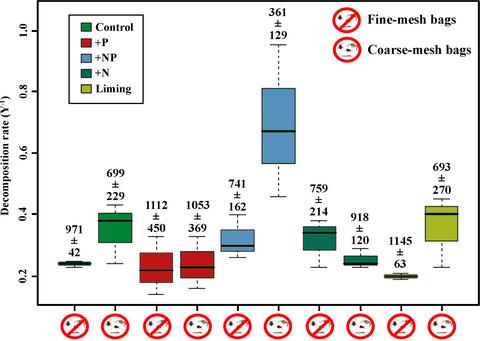当前位置:
X-MOL 学术
›
Austral Ecol.
›
论文详情
Our official English website, www.x-mol.net, welcomes your feedback! (Note: you will need to create a separate account there.)
Soil mesofauna drives litter decomposition under combined nitrogen and phosphorus additions in a Brazilian woodland savanna
Austral Ecology ( IF 1.5 ) Pub Date : 2021-07-13 , DOI: 10.1111/aec.13082 Vinicius Tirelli Pompermaier 1 , Alex Rosa Campani 1 , Ellen Dourado 1 , Luciana Della Coletta 2 , Mercedes Maria da Cunha Bustamante 1 , Gabriela Bielefeld Nardoto 1
Austral Ecology ( IF 1.5 ) Pub Date : 2021-07-13 , DOI: 10.1111/aec.13082 Vinicius Tirelli Pompermaier 1 , Alex Rosa Campani 1 , Ellen Dourado 1 , Luciana Della Coletta 2 , Mercedes Maria da Cunha Bustamante 1 , Gabriela Bielefeld Nardoto 1
Affiliation

|
Nutrient enrichment and the subsequent chemical changes in dystrophic savanna soils may alter plant richness and nutrient use efficiency, thereby affecting leaf litter chemistry and decomposition. However, the role of soil mesofauna in litter decomposition in savanna ecosystems under nutrient enrichment is not well understood. In soils from a long-term fertilisation experiment, we evaluated the decay of leaf litter incubated in fine- and coarse-mesh bags over a year to assess the role of soil mesofauna in litter decomposition in the central Brazilian savannas. Experimental plots were established in a woodland savanna and consisted of nitrogen (N), phosphorus (P), N plus P and lime additions and untreated control (three replicates of each). We evaluated the effect of fertilisation and liming on litter decomposition rates (total, mesofauna-mediated and microbe-mediated) and their relationship with the initial litter quality (N, C, lignin, cellulose and polyphenol content). Litter decomposition rates were significantly higher in coarse-mesh bags in the N plus P treatment compared with the control, which was explained by mesofauna-mediated decomposition but not by the initial litter quality. Litter mass losses in fine-mesh bags were significantly higher in the initial months of the experiment in the N treatment and in the intermediate months in the N plus P treatment compared with the control. This result could be explained by the initial litter N content, although it has not reflected in significantly higher microbe-mediated decomposition rates. The litter mass losses in coarse-mesh bags in the N plus P treatment were significantly higher only in the final months, indicating that microorganisms and mesofauna differentially affect decomposition over time. Our findings suggest that combined N and P addition could alter soil organic matter dynamics in Brazilian savannas by increasing soil mesofauna-mediated litter decomposition rates.
中文翻译:

在巴西林地稀树草原中,土壤中部动物在氮和磷的组合添加下推动垃圾分解
营养不良的稀树草原土壤中的养分富集和随后的化学变化可能会改变植物丰富度和养分利用效率,从而影响落叶化学和分解。然而,在营养丰富的稀树草原生态系统中,土壤中型动物在凋落物分解中的作用尚不清楚。在来自长期施肥实验的土壤中,我们评估了一年内在细网袋和粗网袋中培养的落叶的腐烂情况,以评估土壤中型动物在巴西中部稀树草原凋落物分解中的作用。试验区建立在林地稀树草原上,由氮 (N)、磷 (P)、N 加 P 和石灰添加物和未处理的对照组成(每种重复三个)。我们评估了施肥和石灰对凋落物分解率的影响(总计,中底动物介导和微生物介导)及其与初始垫料质量(N、C、木质素、纤维素和多酚含量)的关系。与对照相比,N+P 处理的粗网袋中的凋落物分解率显着高于对照,这可以通过中部动物介导的分解来解释,而不是由初始凋落物质量来解释。与对照相比,N 处理实验的最初几个月和 N 加 P 处理的中间几个月,细网袋中的垃圾质量损失显着更高。这一结果可以用最初的凋落物 N 含量来解释,尽管它没有反映在显着更高的微生物介导的分解率上。仅在最后几个月,N + P 处理中粗网袋中的垃圾质量损失显着增加,表明微生物和中型动物会随着时间的推移对分解产生不同的影响。我们的研究结果表明,N 和 P 的组合添加可以通过增加土壤中型动物介导的凋落物分解率来改变巴西稀树草原的土壤有机质动态。
更新日期:2021-07-13
中文翻译:

在巴西林地稀树草原中,土壤中部动物在氮和磷的组合添加下推动垃圾分解
营养不良的稀树草原土壤中的养分富集和随后的化学变化可能会改变植物丰富度和养分利用效率,从而影响落叶化学和分解。然而,在营养丰富的稀树草原生态系统中,土壤中型动物在凋落物分解中的作用尚不清楚。在来自长期施肥实验的土壤中,我们评估了一年内在细网袋和粗网袋中培养的落叶的腐烂情况,以评估土壤中型动物在巴西中部稀树草原凋落物分解中的作用。试验区建立在林地稀树草原上,由氮 (N)、磷 (P)、N 加 P 和石灰添加物和未处理的对照组成(每种重复三个)。我们评估了施肥和石灰对凋落物分解率的影响(总计,中底动物介导和微生物介导)及其与初始垫料质量(N、C、木质素、纤维素和多酚含量)的关系。与对照相比,N+P 处理的粗网袋中的凋落物分解率显着高于对照,这可以通过中部动物介导的分解来解释,而不是由初始凋落物质量来解释。与对照相比,N 处理实验的最初几个月和 N 加 P 处理的中间几个月,细网袋中的垃圾质量损失显着更高。这一结果可以用最初的凋落物 N 含量来解释,尽管它没有反映在显着更高的微生物介导的分解率上。仅在最后几个月,N + P 处理中粗网袋中的垃圾质量损失显着增加,表明微生物和中型动物会随着时间的推移对分解产生不同的影响。我们的研究结果表明,N 和 P 的组合添加可以通过增加土壤中型动物介导的凋落物分解率来改变巴西稀树草原的土壤有机质动态。


























 京公网安备 11010802027423号
京公网安备 11010802027423号